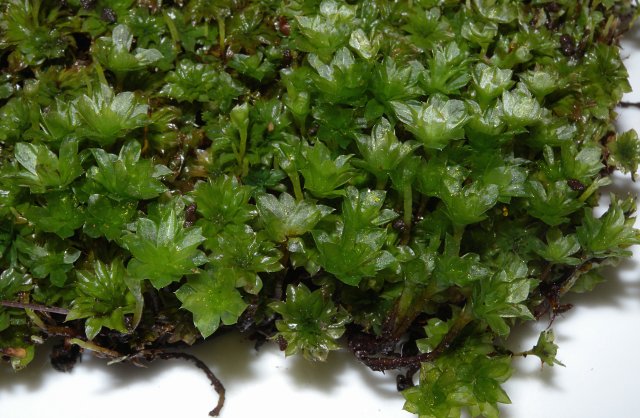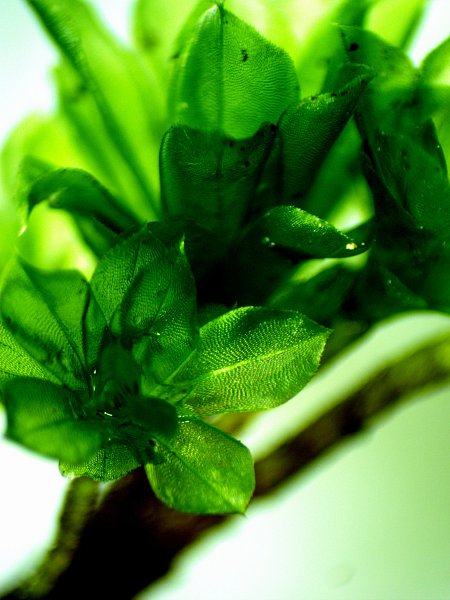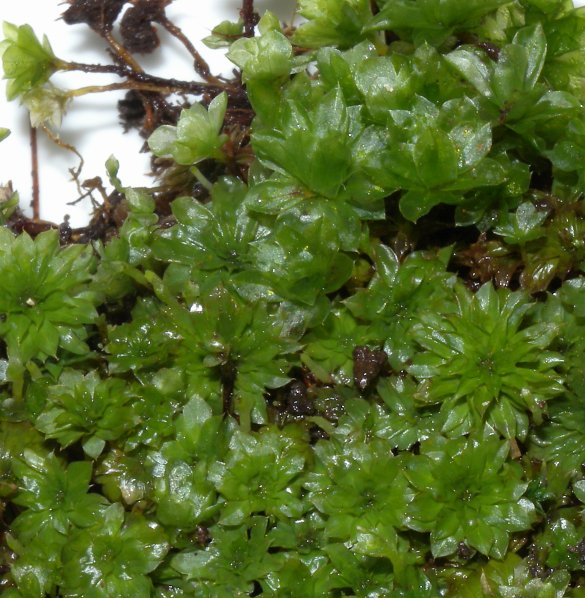
When they are moist, the leaves spread outward and become flatter, providing this moss with a rosette-like appearance. When they are dry, the leaves become more contorted and upwardly incurved. Individual leaf cells have an oblong-hexagonal shape. This moss is dioicous, forming male reproductive organs (antheridia) and female reproductive organs (archegonia) on separate plants. These reproductive organs are located at the apices of mature leafy stems in shallow cup-like structures. The sperm of the antheridia are distributed in part to other plants by raindrop logistics. When fertilization of one or more ova in an archegonia occurs, about 1-5 sporophytes (rarely up to 8) develop. Each sporophyte consists of a slender seta (stalk) with a nodding spore-bearing capsule at its apex. Mature setae are about 2-5 cm. long, orange to red, and more or less erect. The mature bodies of spore-bearing capsules are 4-5 mm. long, cylindrical with a tapered base, slightly curved, and orange to brownish red.

The mature lids (opercula) of the capsule bodies are about 0.5–1 mm. long, short-conical in shape, and orange to red. Both the capsule bodies and lids are covered by hairless membranous hoods (calyptrae), but the latter soon split apart and fall to the ground. After the lids detach from the capsule bodies, both inner and outer rings of narrowly triangular orange teeth are revealed. These teeth regulate the release of the spores; the latter are distributed by the wind. Individual spores are 16-24 micrometers across, globoid in shape, and smooth to finely warty (papillose). The primary stems and the lower secondary stems develop fibrous rhizoids to anchor individual plants to the substrate. This moss reproduces asexually by means of its stolon-like primary stems, which occasionally send up secondary stems with leaves.
Cultivation: The preference is light to medium shade, moist conditions, protection from the wind, and calcareous rocky soil. This moss also grows on logs that are well-rotted.

Range & Habitat: The native Rose Moss (Rhodobryum ontariense) is widely scattered in Illinois and uncommon (see Distribution Map). It occurs primarily in eastern North America, also scattered parts of western North America and Eurasia. In Illinois, habitats include moist ground in woodlands, wooded hillsides, ground at the base of trees in woods, swampy woodlands, shaded clay banks of ravines, moist decaying logs, limestone rocks along streams, moist limestone cliffs, shaded limestone ledges, limestone blocks in woods, thin soil over sandstone rocks in wooded areas, shaded ground in hanging fens, and sandy clay banks along creeks. This moss occurs in high quality natural areas in Illinois, especially in rocky woodlands where limestone is present.
Faunal Associations: Information about floral faunal relationships for this moss is limited. When colonies are formed, this moss provides protective cover for many small invertebrates. It has also been used as construction material for nests by the American Robin (Turdus migratorius); see Breil & Moyle (1976).
Photographic Location: Indoors using nursery-cultivated plants. Close-up photos were taken with a microscope.

Comments: Another scientific name for this moss is Rhodobryum roseum, however this name is now applied to a similar species occurring in Eurasia and the extreme NW section of North America. As a result, most North American specimens of the Rose Moss are now classified as Rhodobryum ontariense. The differences between these two species are quite small. According to Crum & Anderson (1981), the outer leaf margins of Rhodobryum ontariense form a more obtuse angle than those of Rhodobryum roseum (90-120° vs. 65-100°), the lower and middle margins of its leaves are more recurved (rolled downward), and the midribs of its leaves always extend to the leaf tips, rather than falling slightly short of them. In addition, the mature pseudo-rosettes of Rhodobryum ontariense have 18-52 leaves, while those of Rhodobryum roseum have 16-21 leaves. Nonetheless, they regarded such differences as variations of the same moss species, Rhodobryum roseum. Regardless on how this moss is classified, it is one of the more attractive and distinctive mosses that could be cultivated as a ground cover. To distinguish its common name from the English name for the similar Eurasian species, Rhodobryum ontariense could be referred to as the Ontario Rose Moss.